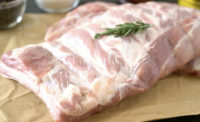According to data from SPINS, a provider of in-store sales data on natural products tracking more than 2 million retail product barcodes, the U.S. has experienced a surge in frozen food buying.
In January 2022, frozen food sales were up by 26% compared to 2020, while SPINS data year over year suggest:
- frozen entrees are up 9.8% in sales
- frozen breakfast foods rose 12.4%
- frozen appetizers and snacks are up 11% in sales.
As 2023 has progressed, however, recent sales data are showing a slowing growth trend.
“Both frozen and refrigerated meat, poultry and seafood are up 5% year over year, and it’s flat for the past 12 weeks,” said Scott Dicker, market insights director at SPINS.
“What we’ve seen in the past year and a half is that consumers have been hit by higher prices at the grocery store, so they have been looking for a lot more whole food options and more nutrient-dense meals,” Dicker said. “Frozen meats is one area we saw them gravitate toward.”
That trend has fueled growth in other staples such as rice, beans, and fruits and vegetables, he said, with the high protein content and relative low price point for proteins being the key driver over the past 18 months.
One factor influencing consumers favoring the purchase of frozen meat products is the ability to stock up on these items.
“When we’re talking about frozen specifically, I think it’s the ability to store it longer,” Dicker said.
But in some cases, refrigerated meat products have outperformed frozen in the past 52 weeks, he said.
“We have seen certain areas where it has been kind of a mixed bag where refrigerated seems to be doing better,” he said. “For (chicken) wings we see that over the past 52 weeks the refrigerated have actually done much better.”
Sales of refrigerated chicken wings were up 35% for that timeframe compared with 6% for frozen, according to SPINS sales data.
Sales data suggest pricing trends for wings are fueling sales.
“What’s interesting about the wings is that over the past 52 weeks both refrigerated and frozen have actually gone down in price,” Dicker said, an anomaly for most categories in the current inflationary market.
However, the sales data analyzed were for branded products and did not include private-label products, he said.
“One thing we’ve always seen in economic uncertain is that people will trade down before they’ll trade out of a category,” Dicker said, adding that private-label brands aren’t necessarily lower quality but do have a lower perceived value.
For another value-oriented mealtime go-to — burgers — refrigerated and frozen product both saw sales decline a few percentage points, he said.
“Refrigerated was down a little less so technically was doing a little better,” Dicker said.
The reason for this consumer purchase trend in burger products can be tied to price increases.
“Those actually had very large price increases — both (fresh and frozen) had double-digit price increases, which is why you’re seeing some of the pullback there” he said.
For meat-based value-added frozen entrees, products incorporating global flavors such as Indian-inspired flavor profiles have experienced growth, Dicker said. He attributes this to the ongoing trend of consumers seeking to re-create a restaurant-style eating experience at home as they pull back from eating at restaurants.
“They still want some of these global cuisines that they used to go out and get from restaurants, similar to what we saw early on in the pandemic,” he said.

.png?height=96&t=1647275041&width=96)





